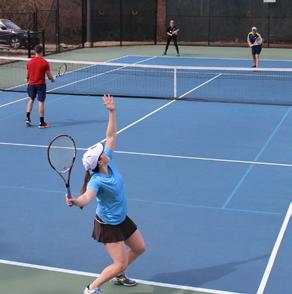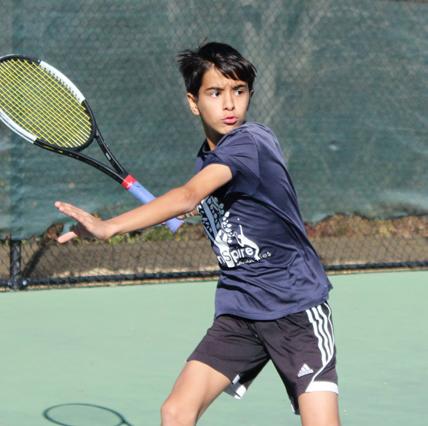
3 minute read
Jensen Zone
Self-Correcting
The first quarter of the 2020 season is upon us, and there are so many story lines on the pro tour. On the women’s side, Cori “Coco” Gauff is taking off! I was concerned about her forehand as I watched her play at Wimbledon 2019. That shot can get short and land in the middle of the court. Gauff played pre dictable patterns; she used her big ground stroke weapon, her backhand, hitting it frequently cross court. But what I saw in the fall with a run at the US Open and winning her first WTA event was next-level good. And what I witnessed from a 15-year-old at the 2020 Austra lian Open was next-level awesome! Her forehand was much deeper on her rally ball, and she could drive it down the line when needed. Additionally, Gauff’s serve is explosive, going into the 118-mph range as one of the fastest serves in the women’s singles draw. Her second serve, however, can get a little out of hand at times.
Because Gauff is not yet seasoned enough to have learned how to self-cor rect, her second serve will stay a mystery — perhaps like it has for Maria Sharapo va who never conquered the double-fault demons. Do you have the double-fault demons? Is there a shot in your game that you and your opponents know is your weakness? All players play on instinct. From the very first ball we hit to the last ball in every rally — whether you know it or not — you are picking up multiple messages as you track the ball. The best instinctive player is the one who never thinks; he or she just reacts. Everything flows for these players and opponents has no way of stopping perfection.
For me, my overheads and backhand passing shots always were automatic, even under the most pressured situations. However, most of my game was not. My second serve was an area of my game that I had to constantly monitor and work on. I was fortunate to absolutely love serving practice. Setting up the three targets of “T,” “body,” and wide serves in both boxes was one of the most enjoyable parts of my training. I grew up in a football culture, so a consistent routine of punting, passing, and kicking 100 footballs each during practice taught me deliberate training discipline that spilled over to my serving training when I developed both my leftand right-handed serves.
Most of my football skills training was done on my own or with my brother, Mur phy. Our parents still were coaching their varsity teams after school, so Murphy and I would practice our football skills at those times. Based on accuracy and distance, it took us a little over an hour to get all 600 punts, passes, and kicks completed. That same approach helped me in self-correct ing service training. I was building tools for a tough, unbreakable serve. I still use so many of those developed skills in my serving today.
When I see Gauff, I can tell that the tennis world is about to be dominated by a wonder kid, the likes of whom we haven’t seen since Maureen “Little Mo” Connolly (1934-1969). From the young age of 10 to 15, Little Mo won 50 tennis championships. At 18, she was the first woman in tennis to win the calendar grand slam. The similarities between Connolly and Gauff are amazing, but unless Coco learns how to fix that second serve, the double faults will haunt her throughout her career. All of you are stepping into spring tennis and competitive league play. Are you ready? Rest for the pressure that can break you, or make you awesome. I am.
— LUKE JENSEN FRENCH OPEN DOUBLES CHAMPION










